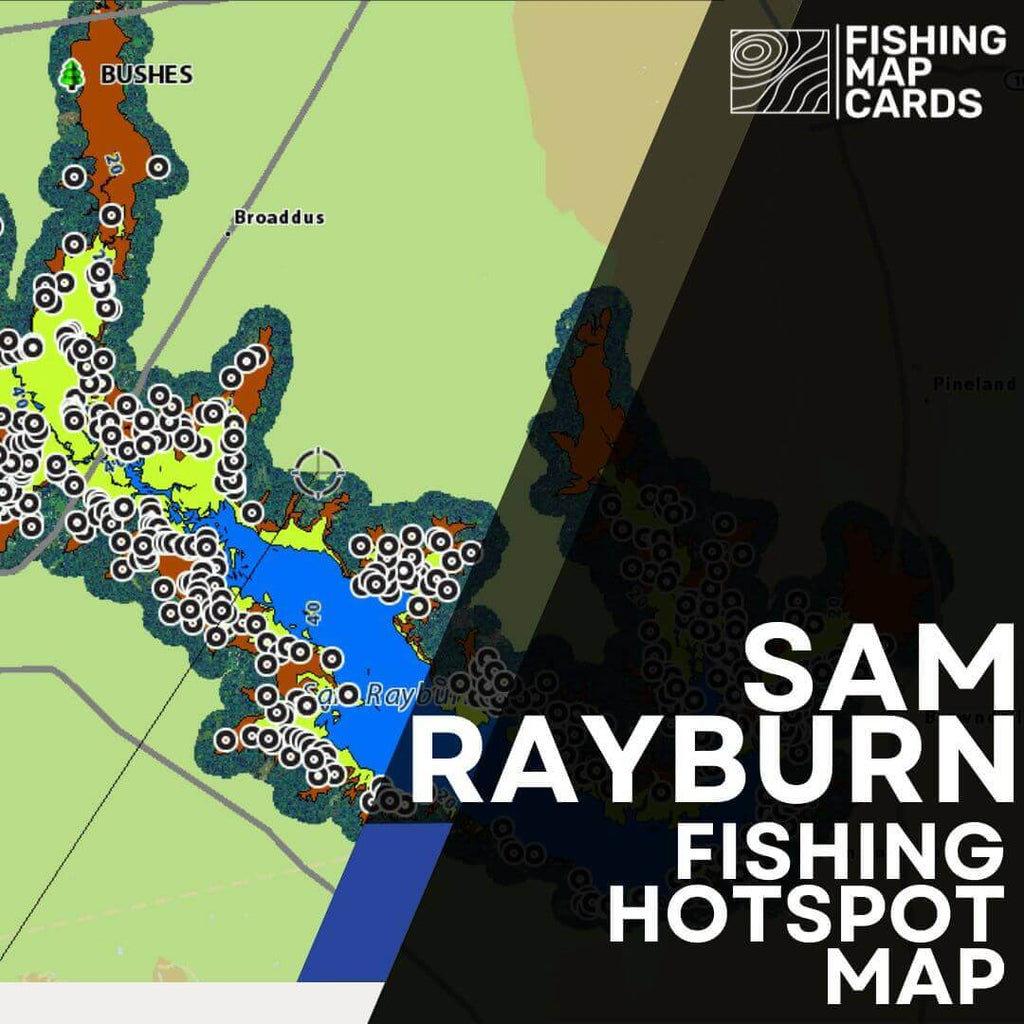Mastering Summer Largemouth Bass Fishing at Sam Rayburn
Sam Rayburn Reservoir, renowned for its diverse bass fishing opportunities, can be particularly rewarding during the summer months if you know where and how to fish. As the water heats up, largemouth bass adjust their habits, making specific techniques essential for success. In this guide, we’ll delve into three key strategies: flipping bushes, targeting deep schools, and fishing brush piles. Gear up for fishing Sam Rayburn for big largemouth with our Sam Rayburn Fishing Hotspot Map.
1. Flipping Bushes
In the heat of summer, many largemouth bass seek refuge in shallow, shaded areas, making flipping bushes an effective technique.
Gear and Setup:
- Rod: A heavy-action rod, around 7'6", to handle the thick cover.
- Reel: A high-speed baitcasting reel to quickly pull fish out of the bushes.
- Line: 20-25 lb fluorocarbon or braided line for durability and strength.
Lures:
- Jigs: ½ to ¾ ounce jigs with a strong weed guard.
- Soft Plastics: Creature baits or craws rigged Texas-style with a pegged tungsten weight.
Technique:
- Approach Quietly: Use a trolling motor to move stealthily to avoid spooking the fish.
- Flip Precisely: Aim for the densest parts of the bushes where bass are likely hiding.
- Be Ready: As soon as your lure hits the water, be prepared for an immediate strike. Set the hook quickly and power the fish out of cover.
2. Targeting Deep Schools
During summer, bass often form schools in deeper waters where the temperature is more stable and oxygen levels are higher.
Gear and Setup:
- Rod: Medium-heavy action rod, 7’ to 7’6”.
- Reel: A baitcasting reel with a good drag system.
- Line: 12-15 lb fluorocarbon line for sensitivity and low visibility.
Lures:
- Deep Diving Crankbaits: Designed to reach depths of 15-20 feet.
- Swimbaits: On a heavy jig head to get down to the deeper schools.
- Drop Shot Rigs: Perfect for suspending a bait right above the school.
Technique:
- Use Electronics: Utilize your fishfinder to locate schools of bass. Focus on ledges, points, and submerged roadbeds.
- Long Casts: Make long casts to avoid spooking the school. Let your lure reach the desired depth before starting your retrieve.
- Vary Your Retrieve: Experiment with different retrieve speeds and patterns to see what triggers strikes.
3. Fishing Brush Piles
Brush piles are man-made structures that provide excellent habitat for bass. These structures are particularly productive in summer when bass seek cover from the heat and predators.
Gear and Setup:
- Rod: Medium-heavy to heavy-action rod, 7' to 7'6".
- Reel: High-speed baitcasting reel.
- Line: 15-20 lb fluorocarbon or braided line.
Lures:
- Texas-Rigged Worms: 10-inch ribbon tail worms with a 3/8 to ½ ounce bullet weight.
- Football Jigs: ¾ ounce with a craw trailer to mimic crayfish.
- Carolina Rigs: With a large soft plastic bait to cover more ground around the brush pile.
Technique:
- Mark Your Spot: Use your electronics to mark brush piles.
- Cast Beyond: Cast beyond the brush pile and slowly work your lure through it.
- Slow and Steady: Use a slow, methodical retrieve, making sure your lure stays in contact with the brush pile.
- Feel for Bites: Be alert for subtle bites, often felt as a slight “tick” or change in line tension.
Final Tips
- Early and Late: Fish early in the morning or late in the evening when the water temperatures are cooler and bass are more active.
- Stay Hydrated: Summer fishing can be exhausting. Bring plenty of water and stay hydrated.
- Stay Safe: Watch for sudden weather changes typical in summer and always wear a life jacket when navigating the reservoir.
With these techniques, you'll be well-equipped to tackle the summer largemouth bass at Sam Rayburn Reservoir. Remember, patience and persistence are key. Happy fishing!





